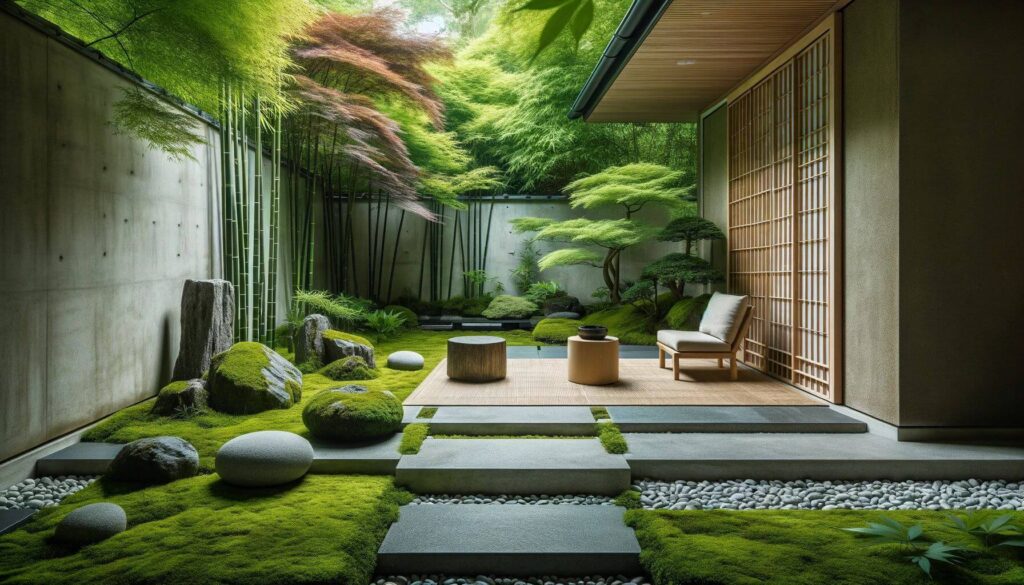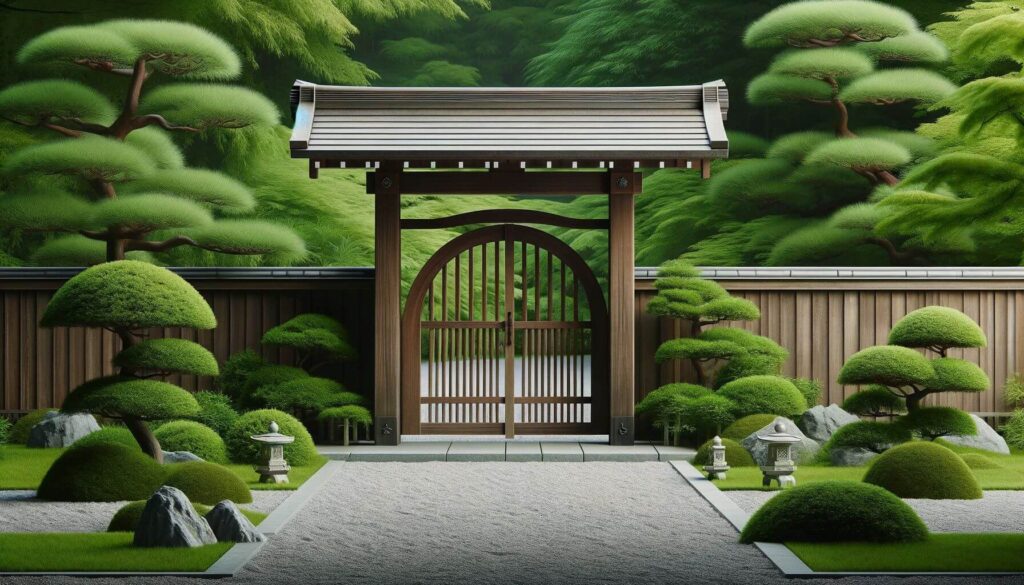
Zen garden, originating from Japan, are a masterpiece of simplicity and tranquility, designed to invoke a sense of peace and meditation. Unlike the lush landscapes of traditional gardens, Zen gardens utilize minimal elements such as sand, rocks, water, and plants to create a serene and contemplative space.
The beauty of Zen gardens lie not just in its physical appearance but in the spiritual dimension it embodies, offering a place for reflection and inner silence. The Zen garden concept is deeply rooted in Zen Buddhism, emphasizing the importance of simplicity, natural beauty, and the mindful appreciation of the present moment.
These gardens are designed to be seen from a single viewpoint outside the garden, presenting an encapsulated landscape that invites the observer into a meditative state. Each element within the garden carries symbolic meaning, from the raked gravel representing the ripples of water to the carefully placed rocks symbolizing mountains or islands.
Creating a Zen garden is an exercise in intentionality and balance. It’s about more than just arranging stones and planting greenery; it’s a philosophical journey that reflects the gardener’s understanding of Zen principles. The process itself can be meditative, offering a unique opportunity to engage with the natural world in a deeply personal way.
As we explore 25 zen garden ideas peaceful and meditative layouts, remember that each design is a suggestion, a starting point for your own creative expression. Whether you have a vast outdoor space or a small corner indoors, the principles of Zen gardening can transform any area into a haven of tranquility.
Essence of Zen Garden Design

Understanding the philosophy and key components behind Zen gardens is essential to creating a space that embodies tranquility and mindfulness.
Understanding Zen Gardens for Your Patio
Zen gardens, or karesansui (dry landscape gardens), trace back to medieval Japan, serving as a tool for Zen Buddhist monks to aid in meditation and reflection. Unlike gardens designed for physical entry and enjoyment, Zen gardens are intended for contemplation from a distance, engaging the viewer in visual meditation and bringing the mind into a state of Zen, or inner peace.
The minimalist approach, with an emphasis on restraint and simplicity, challenges the gardener to think deeply about each element’s placement and its contribution to the overall balance and harmony of the space.
Key Elements of Zen Gardens Design

Zen gardens consist of several key elements, each with its own symbolic meaning and purpose in the garden’s layout.
Sand and Gravel
The raked sand or gravel represents water, with carefully created patterns suggesting waves or ripples. This element symbolizes the fluidity and vastness of the ocean, promoting a sense of calm and openness.
Stones and Rocks
Stones and rocks are the bones of the Zen garden, representing mountains, islands, or other natural formations. Their placement is carefully considered to promote harmony and balance, with each rock chosen for its shape, texture, and the energy it brings to the garden.
Zen Garden Water Feature

While traditional Zen gardens often omit water, representing it with gravel instead, some modern interpretations include water features like small ponds or bamboo fountains. These elements add a soothing auditory layer to the garden, enhancing the meditative experience.
Plants and Moss
Plants are used sparingly in Zen gardens, with each species chosen for its simplicity and elegance. Moss covers the ground in lush green, symbolizing the forest floor, while other plants like azaleas or bamboo add subtle color and texture without overwhelming the senses.
Elements of Zen Garden Architecture
Paths, bridges, lanterns, and gates are often incorporated into Zen garden designs. These features guide the observer’s journey through the garden, both physically and spiritually, leading them through a contemplative narrative.
By integrating these architectural elements thoughtfully, a Zen garden becomes more than just a space; it becomes a reflection of the Zen principles of simplicity, naturalness, and austerity. The design of a Zen garden is a deliberate exercise in minimalism, where less is more, and every detail carries meaning.
25 Peaceful and Meditative Layouts for Your Patios
1. Zen Sand Garden

Start with a vast expanse of fine, white sand, raked into delicate patterns that mimic the ebb and flow of water. This sand zen garden layout focuses on the principle of simplicity, inviting meditation and mindfulness through its minimalistic beauty.
2. Stone and Moss Harmony

Arrange variously sized stones amidst a carpet of lush green moss. This layout symbolizes the harmonious coexistence of the solid and the soft in nature, encouraging a contemplative appreciation of balance.
3. Bamboo Fence Serenity

Enclose your garden space with a simple bamboo fence, creating a secluded retreat. The gentle rustle of bamboo leaves in the wind adds an auditory element of calm, enhancing the sense of serenity.
4. Water Feature Whispers

Incorporate a small, simple bamboo water fountain. The sound of trickling water introduces a calming, meditative element, inviting tranquility into the garden.
5. Stepping Stone Pathway

Create a pathway through your garden using natural stepping stones. This encourages slow, deliberate movement, allowing for a walking meditation practice amidst the beauty of your Zen garden ideas.
6. Koi Pond Calm

Center your garden around a tranquil koi pond. The gentle movements of the fish and the reflective quality of this zen garden water feature encourage a deep sense of calm and mindfulness.
7. Rock Garden Contemplation

Assemble a rock garden with carefully placed stones of various sizes and shapes. This layout invites contemplation, with each rock serving as a focal point for meditation.
8. Miniature Mountain Scenery

Craft a landscape that mimics the grandeur of mountains using strategically placed rocks and low-growing plants. This layout inspires awe and a contemplative appreciation of nature’s magnificence.
9. Zen Pavilion

Erect a small pavilion or seating area within your garden. This serves as a space for meditation, yoga, or simply sitting and enjoying the peaceful atmosphere of your Zen garden.
10. Moon Viewing Platform

Designate an area for moon viewing, a traditional Japanese practice that connects one with the natural cycle of the moon. This layout fosters a deep connection with nature and the universe.
11. Gravel Swirls

Integrate areas of gravel, raked into swirl patterns around rocks or plants. These swirls symbolize the movement and flow of life, inviting reflection on the ever-changing nature of existence.
12. Island of Green

Create an oasis of greenery, such as a moss island, surrounded by a sea of gravel. This layout represents a haven of peace and calm amidst the bustle of daily life.
13. Tea Garden Tranquility

Develop a path leading to a secluded tea ceremony space, emphasizing the Zen practice of mindfulness and the art of tea preparation and enjoyment.
14. Shaded Meditation Nook

Set up a shaded area with comfortable seating, surrounded by tall plants or bamboo screens. This secluded nook offers a private space for meditation or quiet reflection.
15. Garden of Solitude

Find a secluded corner of your garden to place a single bench or stone, creating a space for solitary meditation or contemplation, emphasizing the value of solitude and inner peace.
16. Bonsai Beauty

Incorporate bonsai trees to admire their intricate beauty and the patience and care they represent. Bonsai trees add a living art element, symbolizing harmony with nature.
17. Zen Gate Journey

Install a simple gate at the entrance to your garden. This marks the transition from the outer world to the tranquility within, symbolizing the journey from chaos to peace.
18. Sculptural Elements

Use sculptures that reflect nature or Buddhist principles as focal points for contemplation, adding depth and meaning to your garden’s design.
19. Incense Burner Corner

Dedicate a space for burning incense, enhancing the sensory experience of your garden with calming scents, and inviting a ritualistic element into your practice of meditation.
20. Garden Lantern Lighting

Place garden lanterns to provide gentle illumination, allowing for the peaceful enjoyment of your Zen garden into the evening hours and adding a mystical atmosphere.
21. Rock Cascade

Emulate the presence of water with a dry waterfall made from carefully arranged rocks, symbolizing the flow of life and the soothing nature of waterfalls.
22. Reflection Pool

Include a shallow pool designed to reflect the sky and surrounding greenery, promoting a sense of depth, openness, and introspection.
23. Sensory Plant Selection

Choose plants with calming scents, textures, and colors to gently engage the senses, contributing to the overall atmosphere of peace and serenity.
24. Natural Archways

Create entrances and transitions within your garden using plant-covered archways or bamboo, guiding the visitor on a journey through the landscape.
25. Circle and Square Garden Design

Incorporate the symbolic use of circles and squares in your garden’s layout to represent the philosophical concepts of heaven and earth, adding a layer of depth to your garden’s design.
Designing Your Zen Garden

Creating your Zen garden is a personal journey, an opportunity to express your understanding of Zen principles and your connection to the natural world. Here’s how to bring the peaceful essence of a Zen garden into your own space.
Planning Your Zen Garden Landscaping For Small Spaces
Visualize Your Space
Start by visualizing the space you have available. Whether it’s a small corner of your backyard or a larger area dedicated to your Zen retreat, understanding the dimensions and natural flow of the space is crucial.
Zen Garden Plan with Selected Elements
Decide which elements from the 25 zen garden ideas for small spaces resonate with you. Perhaps the simplicity of raked gravel calls to you, or the gentle sound of a bamboo water feature. Select elements that speak to your version of tranquility.
Sketch Your Design
Create a rough sketch of your garden, placing the elements you’ve chosen in harmony with each other. Consider the balance of the design, ensuring that no single element overwhelms the others, but rather, they all contribute to a cohesive whole.
DIY vs. Professional Help

How To Create a Zen Garden
Many aspects of creating a Zen garden are well within the reach of a DIY enthusiast. Tasks like raking gravel, placing stones, and planting can be deeply rewarding and meditative practices in themselves.
Knowing When to Call in Professionals
For more complex elements, such as installing water features or constructing architectural elements like bridges or pavilions, professional help might be necessary. This ensures safety and the longevity of your garden’s features.
Zen Garden Maintenance
Maintaining Peace
A Zen garden is not only about the initial creation but also about ongoing maintenance. Regularly raking the gravel, trimming plants, and ensuring the cleanliness of water features are all practices that keep the garden in a state of tranquility and beauty. This maintenance itself can be a form of meditation. A way to stay connected with your garden and the present moment.
Designing and maintaining a Zen garden is an exercise in mindfulness. An act of creative expression that reflects your unique path to inner peace. This process results in a beautiful and serene outdoor space. It also offers a sanctuary where you can reconnect with nature, meditate, and find balance in your daily life.
Cultivating Your Inner Peace Through Zen Garden Design

The art of design transcends mere landscaping; it’s a deeply personal exploration of peace, mindfulness, and harmony with nature. By embracing the principles of simplicity, balance, and natural beauty, we open ourselves to a world where every stone, every plant, and every grain of sand can teach us about tranquility and the importance of being present.
How to build a Zen Garden
Zen gardens remind us that peace and beauty can be found in the simplest elements. Through the careful selection and placement of rocks, the thoughtful raking of gravel, and the mindful inclusion of water and greenery, we create more than just a space. We craft an environment that invites us to slow down, breathe, and connect with the moment.
Simple Zen Garden Design For Personal Journey
Your Zen garden is a reflection of your journey toward inner peace and mindfulness. It’s a space that grows and evolves with you, a sanctuary where you can explore your thoughts and emotions in the quiet company of nature. The process of designing, creating, and maintaining your garden is as much a part of your meditation practice as sitting quietly beside a rock or beneath a tree.
Embracing the Spirit of Meditation
As you embark on or continue with Zen garden design, remember to embrace the spirit of Zen: be patient, be open, and be present. The beauty of your Zen garden lies not only in its physical appearance but in the peace it brings to your life and the lives of those who experience it.
Whether you’re drawing your first sketch, placing your first stone, or simply sitting and appreciating the space you’ve created, know that your small Zen garden is a powerful testament to your commitment to peace, mindfulness, and the art of living intentionally.



